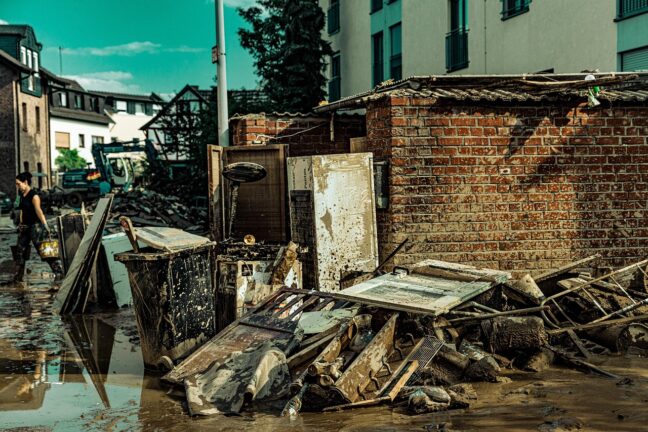Europe is rich enough to rebuild after floods and fires but too short-sighted to insure itself first. A Bruegel debate heard that three-quarters of climate losses across the bloc remain uncovered, piling hidden debts onto taxpayers and banks. Spain’s compulsory scheme shows a fix; Brussels now weighs going continental.
Europe wants to steel itself for fiercer storms and fiercer global competition. That was the thrust of a Bruegel panel in Madrid on September 30th titled “Building a competitive and climate-resilient Europe: the role of finance and insurance”. The debate, chaired by Silvia Merler, a Bruegel non-resident fellow, featured María Luisa Álvarez Barby, insurance advisor to Spanish economy ministry; Bernhard Mayr, financial analyst at European Stability Mechanism; Irene Monasterolo, another Bruegel non-resident fellow; and Francisco Solano Espejo Gil, international relations researcher at the Spanish Insurance Compensation Consortium. They agreed that without deeper insurance cover the continent will struggle both to protect its citizens and to finance the green transition.
Irene Monasterolo of Bruegel set out the numbers. Average cover for climate-related catastrophes meets barely a quarter of expected losses; in Italy the gap exceeds 95 per cent. “Insurance is not there, and this is a major issue for economic and financial competitiveness for the European Union,” she warned. Absent cover, banks mark down collateral, raise loan prices or refuse credit altogether while treasuries inherit reconstruction bills.
A patchwork safety net
Why so little take-up? Charity promises by politicians dull demand, risk awareness is patchy and premiums are dear. On the supply side, insurers suffer liquidity strains when several disasters strike one region, lack geographic diversification and must use forward-looking models that push capital needs higher. Rapid-payout parametric policies help but only partially.
Spain shows how policy can tighten the net. Ms Álvarez of the economy ministry noted that natural-catastrophe risk has long sat inside Solvency II, Europe’s insurance rule-book. Her department has created a sustainability division that now reviews governance, underwriting and investments with green spectacles. Recalibrated Nat-Cat (natural catastrophe, in industry parlance) for charges took effect a few months ago. “Those risks, they are a risk for insurance undertakings,” she said.
You might be interested
Data justify the tweak. Between 2022 and 2024 Spanish claims linked to wind rose 59 per cent and to rain 28 per cent; frequency climbed 48 per cent and 20 per cent respectively. Hail remains the costliest peril, with the average claim more than 15 per cent higher in two years. Household and industrial multi-risk lines saw costs and frequencies rise across the board.
Penetration, at 83 per cent of properties nationally and 95 per cent in pricey markets, looks healthy until maps overlay risk. The Spanish province of Calatayud, scorched by 51 wildfires in a decade, enjoys a protection gap of just 18 per cent yet faces a 50 per cent chance of floods within ten years. Other towns fare worse, prompting Ms Álvarez to urge insurers to reward adaptation and explain cover in plainer language. “Without insurance, there is not coverage of ordinary risks or extraordinary risks,” she reminded the room.
Scanning the horizon
Spanish supervisors now track domestic underwriters’ exposure to heatwaves in Brazil, coastal floods in Asia and wildfires in North America. Scenario analysis stretches to 2050 and 2080 under IPCC pathways, stressing both assets and liabilities. Life assurers must count direct and indirect deaths from heat—a statistical headache when mortality rises faster in cool Galicia than in sun-baked Andalusia.
What should Brussels do? First, compel granular disclosure to jolt lawmakers and households. Second, close the gap through public-private schemes, mandatory mortgage cover, catastrophe bonds and blended finance. Third, let the European Central Bank prod national supervisors: banks’ collateral and sovereign balance-sheets are on the line.
Ms Monasterolo’s forecast was blunt. “Losses will increase because the frequency of extreme weather events and so will the disruptiveness.” Fail to narrow the gap and taxpayers and creditors will pick up the tab—hardly a recipe for a competitive, green Europe.
An elephant speaks
Mr Espejo Gil, deputy director of Spain’s Insurance Compensation Consortium, then seized the microphone. “We have been quite the elephant in the room so far. And now the elephant is going to speak.” His creature carries 144 million policies, automatically extended to floods, windstorms above 120 kilometres per hour, tsunamis, quakes, volcanic eruptions and terrorism. Every motor, home and business policy therefore has “a dual nature”.
The statutory back-stop, founded 70 years ago, shows how a public-private mix curbs fiscal shocks. The 2024 Valencia floods produced more than 250 000 claims, damaged 144,000 cars and will cost about €4.8bn. Yet 38 private insurers helped the consortium settle 97.6 per cent of cases in eleven months. “We are here for low-frequency, high-impact events,” Mr Espejo Gil said; the payout shaved one-third off reserves but left the system intact.
Insurance is not there, and this is a major issue for economic and financial competitiveness for the European Union. — Irene Monasterolo, Bruegel non-resident fellow
Pricing is simple: surcharges on the sum insured vary only by property type, not postcode. Exposure, he noted, has multiplied a thousand-fold since the Industrial Revolution, while property waiting to be destroyed tripled in the first quarter of this century. Warming of 1.3-1.4 °C puts 10 per cent more water vapour in the air, and the Mediterranean is 2 °C hotter than three decades ago—hence heavier rain and bigger hail.
Spain’s springs
Nine in ten buildings around Valencia had flood cover when disaster struck. Optional schemes elsewhere let insurers retreat and governments pay. “If the way that insurance has to protect their portfolios is to exit markets… then is essentially the same, that’s saying that the best way to cope with arthritis in your elbow is to chop your arm off,” Mr Espejo Gil quipped. Rather than tha, Spain instead leans on 144m different “springs”, he said.
Pressure keeps rising, so vulnerability must fall: higher take-up, tougher building codes and smarter land use. Claims data steer planners away from risky sites and guide deductibles. “We have a lot of good risks to compensate for the bad ones,” the researcher said, but the balance needs constant tending.
Bernhard Mayr of the European Stability Mechanism set out the macro stakes. “Those contingent liabilities have an impact on the country, on the fiscal sustainability of the country and therefore we are very strongly interested,” he said. Losses between 2020 and 2023 already outstrip the previous decade, he cited the European Environment Agency. “Things that might well have looked in the past as something that is easily insurable might suddenly not be.”
Banks feel the flood
Bankers suffer a double hit. In Quebec’s worst flood zones insurance has vanished, so banks refuse mortgages, eroding collateral values and borrowers’ solvency. European Stability Mechanism‘s Mr Mayr, raised near the Danube—which flooded in 2002, 2005 and 2023—said repetition taxes regional insurers that lack diversification. Forthcoming ESM research finds a high protection gap drags on GDP almost immediately; a Bank for International Settlements study links physical risk to both GDP and inflation.
What can Brussels try? Mandatory extensions may jar with common-law traditions but deserve study. Cross-border reinsurance pools could harvest diversification—Irish floods rarely coincide with Italian quakes. Capital markets help too: catastrophe bonds, sidecars and parametric triggers lure investors hungry for uncorrelated returns. Spain shows that design, not wizardry, drives penetration; mortgage rules alone push cover to 95 per cent in expensive regions.
Without insurance, there is not coverage of ordinary risks or extraordinary risks. — María Luisa Álvarez Barby, senior insurance advisor at Spain’s ministry of economy, trade, and business
Under-insurance, warned Ms Merler, quickly morphs into a sovereign problem once reconstruction costs hit budgets. Spain proves the chain can be broken. “Besides providing financial resilience, we can also provide physical resilience,” Mr Espejo Gil summed up. Fewer vulnerable assets mean slimmer future claims and sturdier banks.
Who pays, and who stays?
Questions from the floor sharpened choices. Bruegel director Jeromin Zettelmeyer praised Spain’s model but asked where cross-subsidy might snap: would Cantabrians pay triple so Valencia can rebuild? Ms Álvarez answered that education is essential; citizens must grasp their risks, and insurers must write clear contracts. Mandatory mortgage cover, she noted, averts systemic banking shocks. Prices will rise in hotspots, hence the need for doors, drains and quake-braces.
Ms Monasterolo doubted copy-cats would appear without a shove. Supervisors often dismiss natural disasters as immaterial, she said, because incentives are weak. Common EU budgets for post-disaster aid sap urgency. She proposed conditioning EU funds on protection-gap targets and issuing joint green-and-safe bonds to finance adaptation and deepen capital markets.
If the way that insurance has to protect their portfolios is to exit markets, it is essentially like saying that the best way to cope with arthritis in your elbow is to chop your arm off. — Francisco Solano Espejo Gil, deputy director for research and international relations at Spain’s Insurance Compensation Consortium
Mr Mayr stressed prevention’s payoff: the UN reckons “every $1 spent in prevention is worth $15 in recovery and $4 in reconstruction of critical infrastructure.” The snag is disaster myopia; reforms fade once memories fade. Risk-based premiums can jolt households only if subsidies do not blur price signals. “Public awareness is relatively low when it comes to natural disasters,” he said.
Continental pooling
Pooling hazards across borders could cut costs. “The diversification that you get at the national level is actually even higher when you do that in the international or European level,” Mr Mayr argued. A pan-EU back-stop, perhaps run by the insurance-pensions authority, would let firms cede tail risk while competition thrives in the first layer. Savings, if competition bites, “will trickle down in terms of premium costs as well.”
Heather Grabbe, Bruegel senior fellow wondered if correct pricing alone can halt building on flood plains; Britain’s state-backed household cover spares developers the real cost. Another attendee cited Hong Kong, where million-euro flats carry “zero” nat-cat insurance because underwriters flee. Both extremes distort behaviour.
Nothing will change unless Europe conquers disaster myopia. — Bernhard Mayr, financial sector and market analyst at European Stability Mechanism
Mr Espejo Gil rejected talk of charity hazard at home. “We are not providing public grants or even using state budgets. We have a separate accounting, we have our own fund paid by all the policyholders.” The uninsured receive nothing, a spur to stay covered. Spain will not proselytise, he added, but will “honestly explain” its system to any country that asks.
Europe’s next move
An EU agenda is nonetheless forming. First, mandate disclosure so banks and buyers can see flood maps akin to Spain’s. Second, tie EU funds to local uptake and adaptation spending. Third, explore a continental reinsurance pool to avoid the Hong Kong scenario of no cover at any price.
Mr Mayr closed the debate. Prevention yields the highest return, he reminded policymakers, but only if they act before—not after—the next storm surge. Insurers can guide, banks can nudge and Brussels can knit national schemes together. Yet nothing will change unless Europe conquers disaster myopia, he said. The Mediterranean’s warming waters may provide the necessary jolt.
If the Union wants cheap capital, resilient banks and voters spared ruin, it must treat insurance as critical infrastructure. Mandating data, rewarding prevention and pooling risk across borders would cost less than the next Mediterranean deluge. The decision is no longer a technical issue. It is a test of political foresight.





